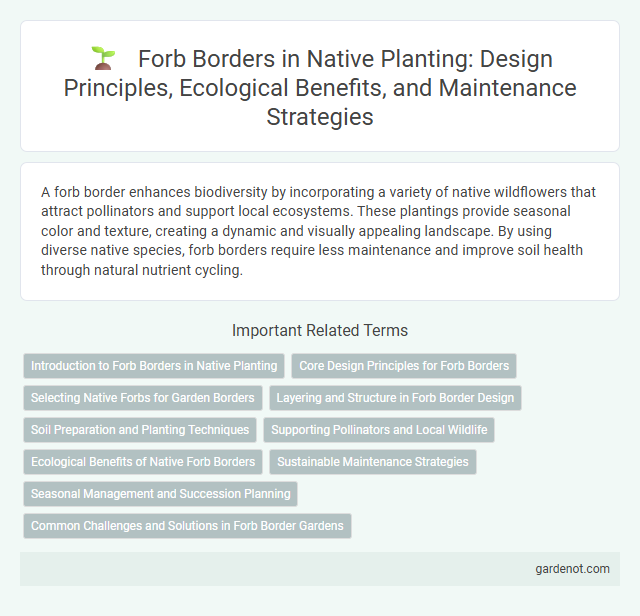A forb border enhances biodiversity by incorporating a variety of native wildflowers that attract pollinators and support local ecosystems. These plantings provide seasonal color and texture, creating a dynamic and visually appealing landscape. By using diverse native species, forb borders require less maintenance and improve soil health through natural nutrient cycling.
Introduction to Forb Borders in Native Planting
Forb borders in native planting enhance biodiversity by incorporating herbaceous flowering plants that thrive alongside grasses and shrubs. These borders provide essential habitats for pollinators and improve soil health through diverse root structures. Selecting native forbs ensures adaptability to local conditions, promoting ecological balance and resilience in garden landscapes.
Core Design Principles for Forb Borders
Forb borders thrive by incorporating core design principles such as species diversity, layering, and seasonal interest to maximize ecological benefits and aesthetic appeal. Selecting native forb species that provide continuous bloom periods supports pollinators and enhances soil health, while arranging plants in clusters mimics natural patterns to encourage resilience and reduce maintenance. Integrating structural variation with height gradients and foliage textures creates dynamic habitats that foster biodiversity and contribute to a sustainable landscape.
Selecting Native Forbs for Garden Borders
Selecting native forbs for garden borders enhances biodiversity by attracting pollinators and providing habitat for local wildlife. Choose species that thrive in your regional soil and light conditions, such as purple coneflower (Echinacea purpurea) or black-eyed Susan (Rudbeckia hirta), to ensure sustainable growth and seasonal interest. Incorporating a variety of native forb species promotes a resilient and aesthetically pleasing garden border.
Layering and Structure in Forb Border Design
Layering in forb border design enhances ecological function and visual depth by combining various native wildflowers with staggered heights and bloom times. Integrating low-growing groundcovers beneath taller forbs creates a resilient structure that supports pollinators and promotes soil health. Effective structuring involves strategically placing species to optimize sunlight exposure and moisture retention, resulting in sustainable, vibrant native plant communities.
Soil Preparation and Planting Techniques
Forb border soil preparation involves thoroughly loosening the soil to improve aeration and drainage while incorporating organic matter like compost to enhance fertility. Planting techniques include spacing forb seedlings according to mature spread, ensuring root systems are well-covered, and watering immediately to promote establishment. Mulching with natural materials helps retain moisture and suppress weeds, supporting healthy growth in native forb borders.
Supporting Pollinators and Local Wildlife
Forb borders play a vital role in supporting pollinators by providing a diverse array of nectar-rich flowers that attract bees, butterflies, and other beneficial insects. Native forb species create essential habitats and food sources for local wildlife, enhancing biodiversity and ecosystem resilience. Incorporating forb borders in landscapes promotes natural pest control and sustains pollination services crucial for healthy plant communities.
Ecological Benefits of Native Forb Borders
Native forb borders enhance biodiversity by providing essential habitat and food sources for pollinators, birds, and beneficial insects. Their deep root systems improve soil health and promote water infiltration, reducing erosion and supporting nutrient cycling. These borders also contribute to ecosystem resilience by supporting native plant communities and suppressing invasive species.
Sustainable Maintenance Strategies
Forb borders enhance biodiversity by incorporating native wildflowers that thrive with minimal intervention, reducing water and fertilizer needs. Sustainable maintenance strategies prioritize selective weeding, seasonal cutting, and mulching to support native pollinators and soil health. These practices promote long-term ecosystem resilience while minimizing resource inputs and labor.
Seasonal Management and Succession Planning
Forb borders require strategic seasonal management to promote healthy growth cycles and maintain biodiversity throughout the year. Succession planning ensures continuous bloom periods by selecting species with staggered flowering times, supporting pollinators from spring through fall. Proper maintenance includes timely cutting back and controlled disturbances to encourage vigorous regrowth and prevent invasive species establishment.
Common Challenges and Solutions in Forb Border Gardens
Common challenges in forb border gardens include managing invasive species, ensuring proper soil moisture, and preventing nutrient competition among plants. To overcome these issues, gardeners can implement regular weeding, install efficient irrigation systems, and use soil amendments tailored to the specific needs of native forbs. Strategic plant spacing and selecting drought-tolerant species also enhance resilience and biodiversity in forb borders.
Forb border Infographic

 gardenot.com
gardenot.com